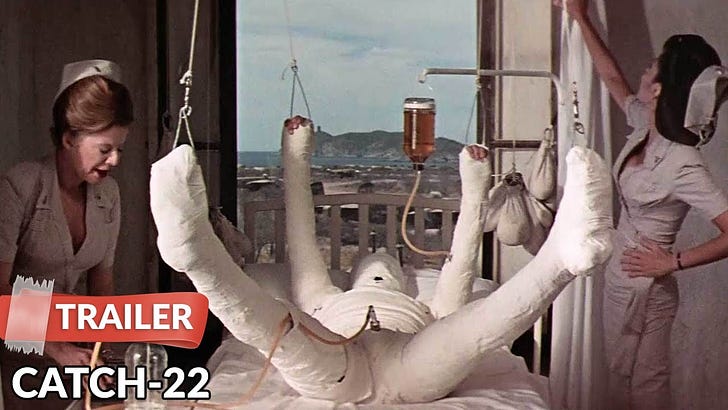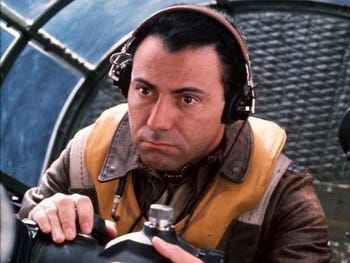Reeling Backward: Catch-22 (1970)
The late Alan Arkin enjoyed one of the all-time great "that guy" film careers, such a reliable utility player people forget his leading role in Mike Nichols' adaptation of the Joseph Heller novel.
“He was very old.”
“But he was a boy.”
“Well, he died. You don't get any older than that.”
Alan Arkin passed recently after one of the all-time great film careers as a character actor, remembered particularly for his many comedic “that guy” supporting roles in the back nine of his career. These include “Little Miss Sunshine” — for which he won the Academy Award — and “Argo.”
The image of him as the irascible older man is now so imbued into his persona that people forget he was a reliable if decidedly offbeat leading man in the 1960s and ‘70s, including two lead actor Oscar nominations. His big role in “Catch-22,” directed by Mike Nichols from a screenplay adaptation by Buck Henry from the seminal anti-war novel by Joseph Heller, is getting a favorable remembrance because of his passing.
I thought it time to check it out, having never read the book or seen the movie. What can I say; it’s one of those novels you tend to experience as a youngster because it was assigned in a high school or college class, and none of my teachers ever did.
The film, which got decent reviews at the time but was seen as a disappointment for such a high-profile project, differed in a lot of ways from the novel. It dumps entire storylines and consolidates characters, or assigns actions and dialogue from one person to another.
Hungry Joe, who has a whole identity as a would-be perverted Life magazine photographer always trying to snap nudes of the nurses, only shows up in the movie long enough to be horrifically, but also hilariously, buzzed in half in the propeller of an airplane as seen from a great distance.
The memorably monikered Major Major Major Major, played by Bob Newhart in the movie, gets downgraded to Captain Major, with only his surname standing duty for his never-mentioned first and middle names. The nervous laundry officer, he gets suddenly promoted to Major Major and commander of a B-25 squadron stationed in Italy 1944, despite having never even flown in a plane. He’s known for fleeing out the window of his office whenever anyone wants to see him.
Arkin plays the main character, Yossarian, a mordant captain and bombardier who’s regarded as the resident troublemaker and malingerer. The story is told from his perspective as a series of loosely connected, chronologically scrambled events as he tries to find a way to get rotated out of active duty after surviving more than 50 flight missions.
Army Air Force personnel are supposed to be sent home after 25 missions, but the self-aggrandizing Col. Cathcart (Martin Balsam) keeps raising the threshold in an effort to gain publicity for himself and the unit. Scribe Buck Henry plays his right-hand “light” colonel, Korn, a combination of enforcer and lickspittle.
The rest of the cast is truly astonishing. It includes Anthony Perkins as the meek, ineffectual chaplain; Bob Balaban as Orr, Yossarian’s tentmate and a pilot who’s notorious for constantly crashing his planes into the Mediterranean; Richard Benjamin as Danby, the obsequious flight commander; Martin Sheen as Dobbs, who likes to bicker with Yossarian over his lack of patriotic fervor; Art Garfunkel, credited as Arthur, as Nately, a kindly if naïve sort who falls in love with an Italian prostitute; Norman Fell as a flunky desk sergeant; Charles Grodin as Aarfy, a pipe-smoking fellow who’s eerily calm; and Jack Gilford as Doc Daneeka, who refuses to ground Yossarian despite his protestations that he’s crazy.
The latter’s exchanges with Yossarian provide the title, a fictional logistical fingertrap the Air Force (or at least Cathcart) came up with. Any airman must be insane to want to keep flying after more than 50 missions, but refusing to fly more proves they’re sane, so they cannot be let off duty. Plus, Daneeka himself would find himself court-martialed for grounding anyone.
A couple more notable cast: Jon Voight plays Milo Minderbender, a lowly supply lieutenant who convinces Cathcart to endorse a little black market operation to pad their service pay. This initially raises Yossarian’s ire in the middle of a mission when he finds all the flight’s silk parachutes have been commandeered and sold off.
This quickly morphs into M+M Enterprises, a criminal syndicate encompassing the entire European war theater. At one point they strike a deal with the Germans to bomb their own base in exchange for taking many tons of surplus cotton off Milo’s hands. In the end he winds up as a Hitler-like figure who’s really running the war.
And Orson Welles — who tried years before to film his own adaptation of Heller’s novel — has a brief two-scene cameo as Dreedle, a general who’s spectacularly indifferent to the plight of his men or the success of the Allied forces. He wanders about doing inspections and the like with his son-in-law and mistress in tow.
Welles gets to share perhaps the most memorable scene in the movie, when Yossarian shows up nude to a medal awarding ceremony. His uniform is still bloody from the demise of Snowden, a young belly gunner who buys it on his very first mission.
It’s obviously a very humorous moment, Arkin standing there naked with a stupid, insouciant grin on his face, probably figuring a few weeks in the stockade are worth it if it gets him out of flying.
But the movie keeps returning to the moment of Snowden’s death in flashbacks, and it gets a little worse each time as Yossarian tries to bandage his bleeding wound. The final iteration is truly revolting, to the extent it sours the laughter we previously enjoyed.
That’s probably my takeaway from the whole of “Catch-22.” It’s generally described as very black comedy/satire, but I don’t think it’s really that funny at all — or meant to be. If it’s possible for a picture to be highly absurdist without actually striving for humor, I think this is it.
The tone feels like a morose mix of Kurt Vonnegut and Federico Fellini, if that makes any sense.
Like Vonnegut’s “Slaughterhouse-Five,” the film takes a very dim view of war, even seen from the perspective of the “good side.” The whole enterprise is evil and chaos incarnate, Heller seems to say, so let’s depict it as a grand circus of despair, death and stupendous human arrogance.
It’s the sort of thing that summons a wry, rictus grin more than a big guffaw.
I think of one little throwaway scene. Yossarian, having woken up in the hospital after being stabbed (in revenge for something he didn’t do, but that’s another story), spies another soldier completely covered in plaster bandages from head to toe. Two nurses approach and disconnect two bottles from the patient: one plasma going into his bloodstream, now empty, and a full one collecting urine. They switch them, then leave without pausing in their gossip.
Nichols and Henry, then hot off the commercial and critical success of “The Graduate,” reportedly spent two years working on the script for “Catch-22.” It had been regarded as unfilmable, but they did their best to stuff it into a two-hour movie. Heller endorsed it despite the many changes from his book, and even volunteered that he wish he’d written some of their dialogue himself.
In 2019 Hulu broadcast an entire miniseries of “Catch-22,” unseen by me, that purportedly more closely hews to Heller’s book. There’s also his much-disregarded sequel novel, “Closing Time,” of which I’m also innocent.
Holding it all together is Arkin as the quintessential everyman antihero, the guy who sees how shitty everything is but is the one person who can’t stop from speaking up. Despite the film’s zig-zaggy, deliberately labyrinthian plot, his Yossarian is the one constant touchstone, a man trying to stay sane in a world gone mad.
In the end Yossarian decides to trade in his integrity and accept a promotion and trip home as a bribe from Cathcart, but at the last minute he opts to chuck it all and paddle away AWOL into the sea. In finally doing something certifiably nuts, he finds his most grounded, intrinsic humanity.





